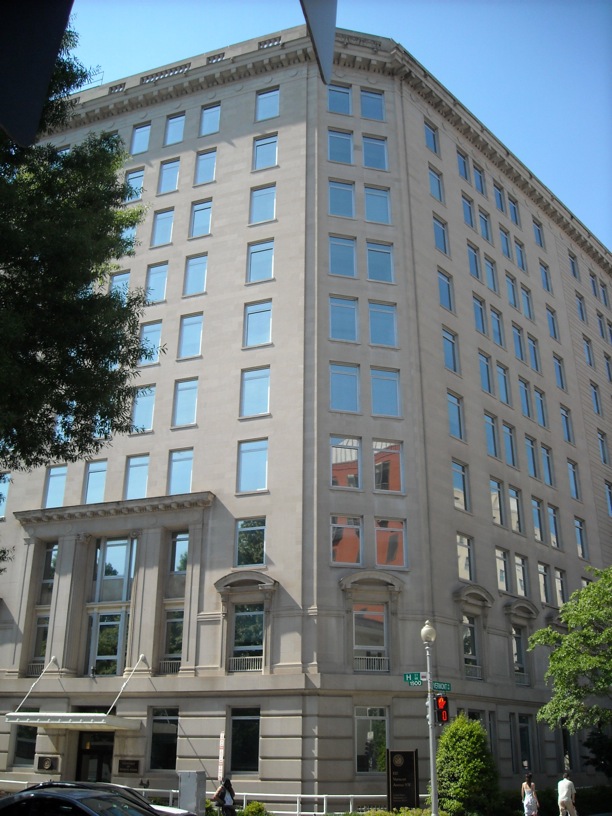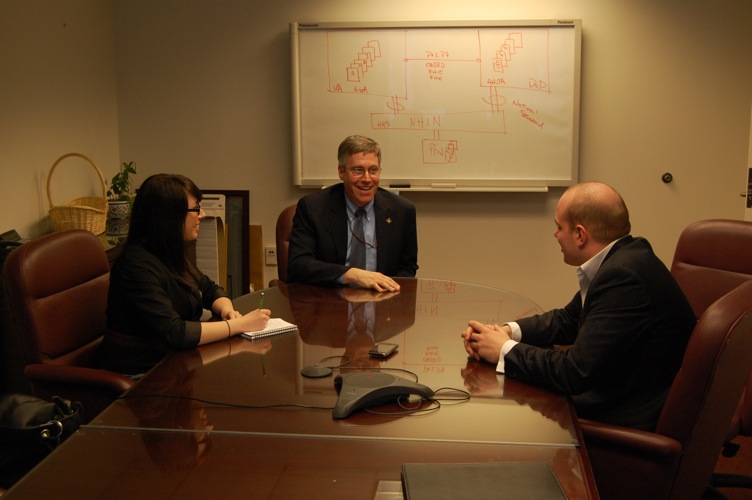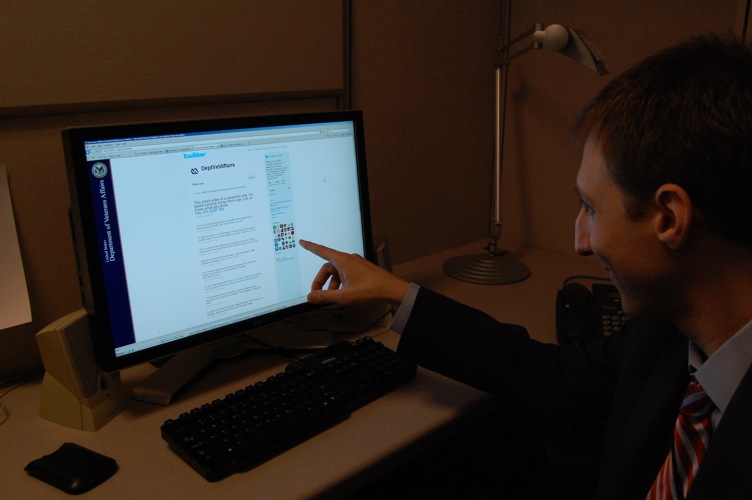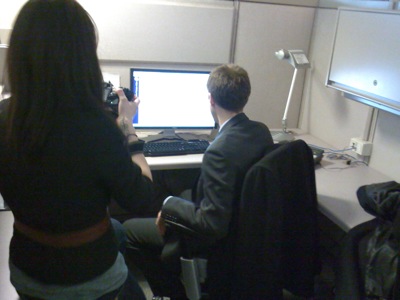To most American Veterans, the Department of Veterans' Affairs, second only to the Department of Defense in size and funding amongst executive departments, is a mythical beast living somewhere in the the annals of Government, untouchable and unknowable to the common former servicemember. Still others see VA in an even more adversarial light, envisioning an entity that connives to withhold well earned benefits and care through any means possible.
As a result of the reputation that VA has amongst the Veterans, it serves Kate Hoit, an Army Veteran who served in Iraq in 2004 and 2005, and myself, having served in Afghanistan in 2007 and 2008, paid a visit to the Department last month to investigate whether such a reputation is warranted.
 It turns out that the Department of Veterans Affairs is not located in some dark dungeon near the River Styx, but resides at the southwest corner of McPherson Square in Northwest Washington DC, in a building that looks like it could be the nondescript headquarters for any other federal agency.
It turns out that the Department of Veterans Affairs is not located in some dark dungeon near the River Styx, but resides at the southwest corner of McPherson Square in Northwest Washington DC, in a building that looks like it could be the nondescript headquarters for any other federal agency.
Kate and I went through the regular search process you encounter when entering any federal building and waited by the elevator for our escort for the day to retrieve us. We were met in the lobby by VA's Director of New Media, Brandon Friedman, himself a former Infantry officer and Veteran of the wars in Iraq and Afghanistan (full disclosure: Brandon Friedman was my predecessor as editor of VetVoice). We went through the customary handshakes and were informed that the Department was excited for our visit. Personally, I was skeptical. Not that I doubt Brandon's honesty. However, I suppose I too had a certain amount of assumptions about the enthusiasm for transparency within the VA.
We took the elevator up to the floor that houses the offices of the Assistant Secretary of Public and Intergovernmental Affairs. The offices are essentially VA's operations center for outreach. From the Department's press secretary, to the website development team, to the guy who takes the photos for VA's Vanguard magazine, if VA communicates with the outside world, it originates from that office. Brandon first introduced us to the press secretary, Katie Roberts. I expected to get the standard company line, but Mrs. Roberts mostly avoided talk related to the professional nature of our visit. She thanked us for our military service, as well as for the work we do for Veterans at VoteVets. She spoke to us as peers-- even friends, which is much different than the usual attitude you get from Congressional staffs and other government officials is this type of setting.
We were also introduced to Tyrone Brown, a retired Navy Veteran who now works on VA's web communications team. Tyrone recently took part in the complete overhaul of the VA website. For those of us that were forced to use the old website, today's iteration is a vast improvement. Tyrone is a humble public servant who stated that there is nothing he enjoys more at VA than helping Veterans, but Brandon made sure to note that Tyrone has put in countless hours and late nights ensuring that VA's most effective resource for communicating with Veterans has become easier and more user friendly.
Kate and I then sat down with Brandon in the Office of New Media, which you can see below:
<
<
Yeah, so the "office" ain't much, but that misses the point, which is that the Department of Veterans Affairs has an Office of New Media. As practitioners of this medium, we all understand its benefits. New media offers not just one way communication, source to consumer, but bi-lateral communication allowing discourse between the consumer and the source. This is an important step in increasing the level of communication between the Department and Veterans and creating a more open, transparent paradigm. As Brandon informed us, this isn't just a token gesture. The VA has requested funds in next year's budget to expand the office and bring on more staffers.
Part of the problem, as Brandon explained to us, with the relationship between Veterans and the VA is that most Vets don't understand how the VA works. As part of their new media outreach, VA has launched or is in the process of launching Twitter and Facebook accounts for the Department and for each of its three subordinate agencies-- the Veterans Benefits Administration, Veterans Health Administration and the National Cemetery Administration which will be operated by the communications arms of those agencies. Additionally, the Department also maintains channels on You Tube and Flickr. The next phase will be to integrate all 148 VA medical centers with Facebook and Twitter accounts. Using these social media tools will allow local VA medical centers to communicate more directly and effectively with the Veterans they serve. VA's Assistant Secretary for Public and Intergovernmental Affairs Tammy Duckworth is already using Twitter to communicate with Veterans. Ultimately, Veterans will be able to access a directory on the VA website which will point them to all of the various new and social media outlets where information on benefits and services can be found.
"For too long, a lot of Veterans have felt as though they can't communicate with VA when they have a problem," Friedman told us. "I know that's how I felt. That results in wasting Veterans time, and these Web 2.0 tools that the VA is using in our new media outreach efforts are going to change that. This will allow us to more efficiently and more effectively communicate with Vets, which increases our ability to serve them."

Speaking about the G.I. Bill specifically, Dr. Levin stated that "From the Veterans perspective, it's just going to be better. It's going to be a simpler process with more reliable outcomes, meaning that Vets will know when they are going to get their check and for how much their check will be. We're essentially automating very complicated rules."
Dr. Levin was brutally honest about those complicated rules and how the VA is currently working with them. "What we're stuck with today is, effectively, an Excel spread sheet. 'This guy lives in Austin, is taking these classes, has this type of service' and the number comes out. We're fixing that."
According to Dr. Levin, what VA has called the "Long Term Solution" for processing G.I Bill claims, a system that will essentially make claims completely automated, will be implemented by the end of this year. After which the current system, which Dr. Levin acknowledged has been "horrific", can become just a bad memory for beneficiaries and the VA, both of whom understand that the status quo has not done justice to Veterans.
One question I asked of both Brandon, regarding his work with web 2.0 tools, and Dr. Levin, regarding reforming the technological infrastructure of the Department, was whether or not the VA from top to bottom possesses a culture that is conducive to change. Anyone who has military experience knows how systems become resistant to change. Something is done one way because it has always been done that way. Try to change the system and you encounter those who have always operated in a specific manner who will tell you "that's not the way it's done here", and that becomes the death of your change initiative.
Brandon stated that while different organizations within VA face a learning curve for the new technology, the individuals tasked with implementing new and social media into their communications strategy are eager to learn. Dr. Levin was even more emphatic, stating that the culture within VA was "exactly the opposite" of what I described. Last year, Dr. Levin, with the assistance of Craigslist founder Craig Newmark, participated in VA's Innovation Initiative. I could explain to you what the Innovation Initiative is, as described to Kate and I by Dr. Levin. However, why do that when the White House already asked Dr. Levin to tell America about VA's efforts himself:
Dr. Levin informed us that what he discovered in the Innovation Initiative is that there is a false, although not malintended, presumption that if VA tries to change process or policy at the top, the Department will encounter friction from lower levels. Apparently, the situation within VA could not be more different. When Dr. Levin spoke to the directors at regional benefits centers, they were more than enthusiastic about making any changes that will help them better serve Veterans. To quote Dr. Levin, their response was "'Hell yeah, let's do it!', and the enthusiasm was stunning. 'Here's what we should be doing!', 'We've been telling these guys for years this is what we should be doing!' and 'Thanks for listening!'"
Ultimately the Innovation Initiative collected over 3,500 ideas from VA employees over the course of two weeks. Winners were selected and those winners will receive funds to implement their proposed changes. What may be more exciting than the funding is that over half of the winning ideas won't receive money because they don't even need it. They are simple policy changes that will allow the Department to function more efficiently while simultaneously saving tax payer dollars.
In the course of our exchange on the Innovation Initiative, something happened that I think is worth highlighting. At one point, there a was knock on the door of our conference room and a senior Department leader, who shall remain nameless but who's position requires Senate confirmation, entered. The leader was scheduled to use the room at the time and asked if we were about finished. Dr. Levin told him no, we would need some more time. Now, I don't know if I'm reading too much into that, but to me, it speaks volumes about the importance the VA placed on our visit that the CTO told a leader at that level that he'd have to wait his turn.
Our final question for Dr. Levin involved the process of records migration from DoD to VA. As I told the CTO, it seems pretty silly to me and a lot of other Vets than one executive agency has all the information about where we served and for how long, yet when we go to another agency to get benefits we are charged with an inordinate amount of red tape to document that service in order to obtain benefits we've earned. Dr. Levin described stream lining that process as "the other 100 percent of [his] job." As he informed us, VA understands the frustration, and is spending millions of dollars to allow Veterans to integrate records between organizations the same way we already do with banking and car insurance. Doing so is a top priority of the Department and they have set a goal for national roll out in 2012.
Needless to say, Kate and I came away with a very different picture of the Department of Veterans' Affairs from the one with which we entered that building. The Department is a valuable institution that is well aware of the problems with its processes and reputation in the past. It is a department that is chocked full of dedicated public servants, many of them Veterans themselves, who work diligently day in and day out with a deep passion for serving Veterans. Moreover, the Department bears a deep concern for not just improving the lives of Vets, but for ensuring that Vets know that communication with VA is not a one way street.
And that's really the most important facet of this story. All of the institutional improvements only become possible with open lines of two-way communication. The fact that an agency, which was once thought to be a malicious beast in a bureaucratic dungeon, is taking the lead amongst all executive departments by allowing bloggers such unprecedented access speaks volumes to the commitment the VA has to its Veterans. Personally, as a Veteran, I take pride in the fact that the department that serves our community exclusively has become the standard bearer for interaction between citizens and government.

